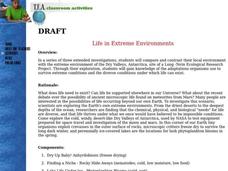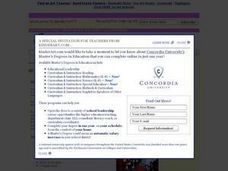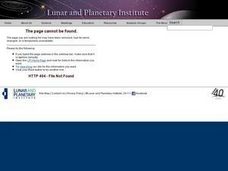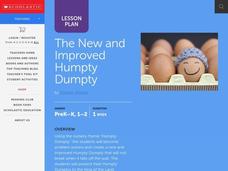Curated OER
Photosynthetically Available Radiation (PAR) Measurements Part 1: Calculating the Solar Constant using a TI-8
Twelfth graders are introduced to the term Photosynthetically Available Radiation. In groups, they participate in an experiment to determine how ecosystems survive the conditions in the Arctic. They calculate the amount of solar energy...
Curated OER
Cave Painting in the Ice Age
Students take notes and sketch during the Internet research. They take notes of the colors found in the cave paintings (black, browns, ochre, sienna). They create an initial full size comprehensive sketch on scrap paper and in their...
Curated OER
Life in Extreme Environments
Students compare and contrast local environments with the extreme environment of the Dry Valleys, Antarctica. Students explore and gain knowledge of the adaptations organisms use to survive extreme conditions and the diverse conditions...
Curated OER
Ghoulish Stick Figures
Students create two-headed snakes, centipedes, ghostly trees, "Handy Herman", and ghosts in this Art activity for the Halloween holiday. Each craft could be used separately or they could be combined to create a day-long activity.
Curated OER
Wacky Water Critters
Students visit a local creek or stream. They collect water samples from the creek and observe and sort the "water critters" they find in the sample, observing smaller organisms under a microscope if necessary. They identify each organism...
Curated OER
Clay Pot Winter Friends
Students create ice blue, clay pot winter friends using clay pots, ice blue paints, markers, felt, and fabric in this Art lesson for the winter time. The lesson would be ideal for the early elementary classroom during the winter months.
Curated OER
A Waste Not Picture Frame
Students reuse old puzzles with missing pieces by painting the remaining pieces and using them to make a picture frame. They embellish the frame with other recycled items.
Curated OER
Penguins, Penguins, Penguins
Young scholars create "juice bottle penguins" using paper mache, water-based paints, water, and recycled juice bottles. This lesson is intended for early-elementary students and is great as a post-activity for a lesson or unit on...
Curated OER
Space Science: A Scoop of Moon Dirt
Students discover soil characteristics and how it is formed on Earth and the Moon by examining local samples to a lunar simulant. They replicate the effects of wind erosion by scraping dry bread with sandpaper. Students use rocks and...
Curated OER
Mud Puddles And Bubbles
Students create muddy foot prints, "paint" with their feet, and explore the uses of bubble mix in this three-part lesson for the early-elementary classroom. The three activities can be used separately, or adapted depending on the...
Curated OER
Glue Art
Students create an art project using glue and food coloring. In this art lesson, students are given a piece of wax paper and glue is poured in the middle of the paper. Finally, food coloring is dripped on one drop at a time with the...
Curated OER
Environment: Erosion Boxes
Fourth graders discover how the processes of erosion and weathering alter the physical characteristics of the environment. In a student log,they record the various types of erosion and list ways to prevent it. Using clear, plastic...
Curated OER
How Much Cereal
Second graders investigate volume through the use of measuring cups. They complete a variety of measuring tasks using kitchen measuring cups. Students accurately measure the volume and compare the results.
Curated OER
Effects Of Weathering
Third graders simulate weathering and erosion using sand and soil. They define weathering and the ways in which surfaces become weathered. Working as a class, 3rd graders complete various activities that demonstrate physical and...
Curated OER
The New and Improved Humpty Dumpty
Learners help Humpty Dumpty. In this nursery rhyme lesson, students listen to the nursery rhyme and then use their problem solving skills to rebuild broken eggs. Learners create new Humpty Dumptys from unbreakable materials.
Curated OER
Limu Party
Young scholars explore limu in their everyday lives. In this science lesson, students identify various uses of limu and discuss common household products that contain limu. Young scholars participate in a limu party.
Curated OER
Acid and Base Activities
Students experiment with acids and bases. In this elementary level chemistry lesson, students perform activities for testing acids and bases. They use universal indicator paper to determine which substances are acidic and which are...
Curated OER
Energy Resources
In this energy resources worksheet, students read about the greenhouse effect and global warming. Then they explain why scientists are so concerned with greenhouse gases. Students also describe how global warming affects people worldwide.
Curated OER
Make a Comet Model and Eat It!
Students create models of comets. They develop a comet model in a team and exchange samples with other teams. They use their senses to demonstrate the filters on a spectrometer and record their data. They discuss the contents of their...
Curated OER
Invisible Ink - Demonstration
Students observe a demonstration that shows that the indicator, phenolphthalein, is a chemical that displays different colors depending on either the acidity or the basicity of the environment. They use the substance to reveal secret...
Curated OER
Liquid Crystal IR Detector
Middle schoolers experiment with one method of detecting infrared radiation. They simulate the detection of infrared radiation using a liquid crystal sheet.
Curated OER
Pioneer Farm Cooking
Pupils explore pioneer farm life and the types of cooking and ingredients available. They recreate a pioneer version of a sno-cone and discuss why crushed ice was used more often than snow in this recipe.
Curated OER
Contemporary Figure Heads
Students will compare historical figureheads to determine their purpose and meaning for the sailing vessels. They will use plaster to carve and create figureheads that are contemporary representations of themselves and their culture.
Curated OER
The Same But Different
Third graders observe a frozen container filled with ice and discuss what happens when the ice sits out in the room. They practice measuring the mass and volume of the ice, watch as the frozen container is placed in a warm water bath to...























